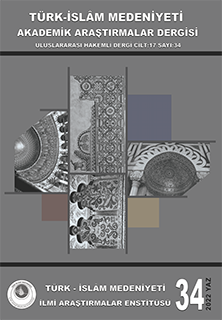İstanbul Merkez Efendi Külliyesi Haziresi Hattat İmzalı Mezar Taşları
DOI:
https://doi.org/10.5281/zenodo.6468611Anahtar Kelimeler:
İstanbul, Merkez Efendi, Hazire, Mezar taşı, Hattat, İmzaÖzet
Merkez Efendi Külliyesi Haziresi İstanbul’un önemli ziyâret mekânlarından biri olan Merkez Efendi’nin (ö.1552) türbe ve tekkesi etrafında gelişmiştir. Mevcut şâhidelerden hareketle XVIII. yüzyılın ortalarından itibaren defin yapılmaya başlandığı görülmektedir. Gerek Osmanlı gerekse Cumhuriyet dönemlerinde yoğun defin yapılan bir hazire olmuştur. Bundan dolayı haziredeki mezarların yarısı Cumhuriyet dönemine aittir. Her ne kadar bir tekke haziresi şeklinde oluşumuna başlamış olsa da toplumun farklı meslek, sınıf ve tabakalarından kişiler de buraya defnedilmiştir. Hazirenin gelişimini Merkez Efendi Tekkesi’nin Osmanlı dönemi İstanbul’unda Sünbül Efendi Tekkesi’nden sonra HalvetîSünbülîliğin ikinci önemli merkezi olması etkilemiştir. Ayrıca Cumhuriyet döneminde Kenan Rıfâî’nin (ö. 1950) ve sonrasında müntesiplerinin buraya defnedilmesi hazirenin günümüze kadar gelişimini devam ettirmesini sağlamıştır. Böylece iki yüz yirmi dört mezarın bulunduğu büyük bir hazire meydana gelmiştir. Hazirelerde bulunan taşlar farklı açılardan değerlendirmelere tabi tutulan araştırmalara konu olabilmektedir. Çalışmamız ise hazirede bulunan hattat imzalı mezar taşları üzerine yoğunlaşmıştır. Hazirede on bir ayrı hattata ait yirmi altı mezarda imza tespit edilmiştir. Burada imzası bulunan hattatlar arasında Sâmi [Efendi], Mahmud Cemâleddin, Emin [Efendi], Sû’ud, Halim [Özyazıcı] , Hâmid [Aytaç], Aydın [Yüksel], Kemal [Batanay] ve Nuri [Efendi] bulunmaktadır. Haziredeki hattat imzalı mezar kitabelerinin tamamı incelenerek hem sanat tarihi hem de hat tarihi açısından Merkez Efendi Hazire’sinin önemi belirlenmeye çalışılmıştır.
Referanslar
Acar, M. Ş. (2004). Ünlü Hattatların Mezarları: Gelimli Gidimli Dünya, İstanbul: Gözde Yayınevi.
Açıkgözoğlu, A. S. (1995). Eyüp Sultan Civarında İmzalı Mezar Taşları, (Yüksek Lisans Tezi, Marmara Üniversitesi, 1995).
Açıkgözoğlu, A. S. (2005). “Hekimoğlu Ali Paşa Câmii Hazîresi”, Kaybolan Medeniyetimiz-Hekimoğlu Ali Paşa Câmii Hazîresi’ndeki Tarihî Mezar Taşları, 16-25.
Berk, S. (2000). “Eyüp Sultan Sınırları İçersinde Hattat Mustafa Rakım’a Ait Mezartaşı Kitabeleri”, Tarihi, Kültürü ve Sanatıyla Eyüp Sultan Sempozyumu III Tebliğler, İstanbul: Eyüp Belediyesi Kültür ve Turizm Müdürlüğü, s. 242249.
Berk, S. (2016). Zamanı Aşan Taşlar-Zeytinburnu’nun Tarihi Mezar Taşları (2. Baskı), İstanbul: Zeytinburnu Belediyesi.
Çalış, E. (2019). “Ahlat Selçuklu Meydan Mezarlığında Bulunan Babacan bin Toman İmzalı Bir Mezar Taşı”, Iğdır Üniversitesi Sosyal Bilimler Dergisi, Sayı: 18, s. 177-192.
Derman, U. (1997). “Hattat”, TDV İslâm Ansiklopedisi, İstanbul, C. 16, s. 493-499.
Derman, U. (1973). “Türk Yazı Sanatında İcâzetnâmeler ve Taklid Yazılar”, VII. Türk Tarih Kongresi Bildiriler-Ankara: 25-29 Eylül 1970, Cilt II, , Ankara: Türk Tarih Kurumu Yayınları, s. 716-728.
Derman, U. (1975). “Mezar Kitâbelerinde Yazı San’atımız”, Türkiye Turing ve Otomabil Kurumu Belleteni, Sayı: 49/328, s. 36-47.
Derman, U. (2019). “Hat Tarihinde Hattat İmzâ ve Şecereleri”, Ömrümün Bereketi: 3, s. 139-159.
Gün, R. (2003). “Mezartaşı Kitabelerindeki İmzaların Referansı Sorunu: SamsunÇarşamba Rıdvan Paşa Camii Haziresindeki İki Mezartaşı Örneği”, İSTEM, Yıl: 1, Sayı: 1, s. 151-156.
İşli, E. N. (1991). İstanbul’da Gömülü Şairlerin Mezar Kitabeleri (Yüksek Lisans Tezi, Marmara Üniversitesi, 1991).
Nefes, E. (2006). “Samsun Körkçüoğlu Mezarlığı’ndaki Kitabesinden Hareketle Hattat Mısrî-zâde ile İlgili Bir Değerlendirme”, EKEV Akademi Dergisi, Yıl: 10, Sayı: 29, s. 289-295.
Nuhoğlu, M. (2003). Koca Mustafa Paşa (Sünbül Sinan) Camisi Haziresi Mezar Taşları Üzerine Bir Arşatırma, (Yüksek Lisans Tezi, Marmara Üniversitesi, 2003).
Özdemir, Y. (2018). Galata Mevlevihanesi Müzesi (2. Baskı), İstanbul: Türkiye Turing ve Otomobil Kurumu.
Özgen, M. (2018). “Fazıl-ı Fena Fil Evkaf” Arşivinde Hattat Mezar Taşları, Atlas International Refereed Journal on Social Sciences, 4/14, s. 1477-1498.
Sürün, M. (2006). İstanbul Şeyh Vefâ Camii Haziresi: Mezar Taşları Üzerine Tipolojik Bir Deneme (Yüksek Lisans Tezi, Marmara Üniversitesi, 2006).
Tanman, M. B. (1994). “Merkez Efendi Külliyesi”, Dünden Bugüne İstanbul Ansiklopedisi, Cilt: 5, s. 396-400.
Taşçıoğlu, M., Acar, Ş. (2014). “Bir Hattatın Dönüşümü: Alfabe Devrimi’nin Halim Efendi’nin Çalışmaları Üzerinden İncelenmesi”, Osmanlı Bilimi Araştırmaları, 15/2, s. 81-98.
Tebrizi, M. A. K. (1999). Ijazat Nameh-Icâzet Name: The most unique and precious document in Ottoman calligraphy, London.
Tüfekçioğlu, A. (2019). Üsküdarlı Taşçılar ve “Taşçı” İmzalı Mezar Taşları, X. Uluslararası Üsküdar Sempozyumu 19-21 Ekim 2018, İstanbul: Üsküdar Belediyesi, Cilt III., s. 93-128.
İndir
Yayınlanmış
Nasıl Atıf Yapılır
Sayı
Bölüm
Lisans

Bu çalışma Creative Commons Attribution-NonCommercial 4.0 International License ile lisanslanmıştır.







